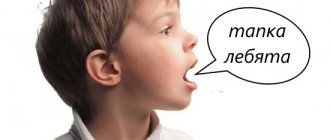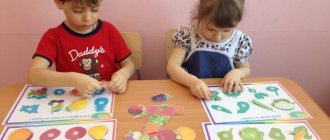It is important for parents to remember that timely contact with a speech therapist will allow:
- prevent difficulties in mastering writing and reading;
- avoid difficulties in mastering the Russian language;
- correct deviations in the development of certain mental functions (attention, perception, memory);
- avoid psychological difficulties when a child communicates in a group of peers;
- reduce the risk of stuttering.
Overcoming shortcomings in sound pronunciation requires a certain system and special methods of correction work.
At the “Easy to Speak” Speech Development Center, sound pronunciation disorders are considered from the point of view of an integrated approach, therefore the following tasks are solved in classes in a fun and accessible way:
- normalization of muscle tone (if necessary);
- development of correct articulation patterns;
- formation of correct speech breathing;
- development of auditory and auditory-verbal attention;
- development of phonemic awareness;
- developing skills in sound analysis and synthesis;
- expansion and activation of vocabulary;
- activation of speech and communication;
- development of memory, attention, thinking.
The most effective format is an individual speech therapy lesson, but the option of a group speech therapy lesson is not excluded, when work is carried out to train correct speech patterns, develop breathing, and coherent speech.
Speech therapist classes in kindergarten are most often both individual and group, subgroup and frontal, which is due to the constant number of children in the group and their distribution according to the degree of sound pronunciation impairment. In a private speech therapy center, for example, in the Speech Development Center “Easy to Speak”, an option for individual lessons is provided.
Video fragment of a lesson with a speech therapist
The structure of an individual speech therapist lesson with children with sound pronunciation disorders at the Speech Development Center “Easy to Speak” is as follows:
- Organizing time;
- self-massage and a set of facial exercises;
- articulation gymnastics;
- a set of exercises for the development of speech breathing;
- sound production/sound automation (depending on the training period)
- development of fine motor skills;
- exercises to activate phonemic hearing/develop sound analysis and synthesis (depending on the period of training);
- development of cognitive processes (memory, attention, thinking).
Video fragment of a lesson with a speech therapist
A session with a speech therapist lasts 30 or 45 minutes.
The speech therapist conducts classes several times a week, depending on the severity of the speech disorder.
Speech therapist's lesson on sound production [P]
Speech therapist's lesson on sound production [P]
Some parents, turning to us for help, mistakenly believe that the child needs to correct the letter “r”. In fact, we are talking about the incorrect pronunciation of the sound [P]. What worries many parents most is the incorrect or distorted pronunciation of this sonorant sound.
Disadvantages of sound pronunciation are divided into several groups. Impaired pronunciation of the sounds [P], [P'] is usually referred to as “rotacism”.
Types of impaired sound pronunciation:
- distortions are abnormal pronunciation of sounds that are not found in speech (for example, the throaty pronunciation of the sound [P]);
- substitution - using, instead of a sound that is absent in speech, another sound of the same language - its substitute (for example, “lyba” instead of “fish”, “vaketa” instead of “rocket”);
- omission - absence of sound due to unformed articulatory posture or due to impaired phonemic hearing (for example, “kaova” instead of “cow”)
- confusion - insufficient differentiation of two sounds that are similar in sound or articulation during their pronunciation (“laketa” instead of “rocket”)
Types of distorted pronunciation of sounds [P], [P']:
- interdental - the tongue is thrown out of the mouth, one blow is heard;
- single-impact – with correct articulation of sound, one blow is made on the alveoli with the tip of the tongue;
- proto - correct articulation of sound without vibration, a fricative sound is heard;
- gular - the tip and front part of the back of the tongue are lowered down and pulled back, the back of the back is sharply arched. A strong stream of air causes either the soft palate (velar rhotacism) or the uvula (uvular rhotacism) to vibrate;
- lateral - with correct articulation of sounds, one of the lateral edges of the tongue is lowered, passing a stream of air to the side. It can trap saliva, causing a squelching sound. 1 – 2 beats are heard;
- coachman - lips moved forward. A strong stream of air causes the lips to vibrate;
- nasal - the tip and the front part of the back of the tongue are lowered and pulled back, the back part of the back of the tongue is tense and raised to the soft palate, forming a gap or bow. When bowed, the sound takes on a nasal tint.
Types of sound replacements [P], [P']:
- replacements with any vowel sounds: “yak” instead of “rak”, “iepa” instead of “turnip”;
- replacements with sonorant sounds: “lak” instead of “rak”, “nama” instead of “rama”, “juka” instead of “ruka”, “Lyoma” - instead of “Roma”;
- replacement with labiodentals: “kavova” instead of “cow”;
- replacement with front-lingual ones: “dak” instead of “rak”, “depa” instead of “turnip”;
- replacement with back-lingual ones: “gak” instead of “cancer”, “gepa” instead of “turnip”.
Work on correcting violations of sound pronunciation begins with the development of mobility of the organs of the articulatory apparatus. Articulatory gymnastics helps develop the movements of the organs of the articulatory apparatus.
Articulation gymnastics exercises:
- are selected purposefully;
- are held at the beginning of the lesson;
- fixed at home;
- require 5-7 minutes to complete.
To produce the sounds [P], [P'], you must perform the following articulatory gymnastics exercises:
A basic set of exercises for developing the basic movements and positions of the organs of the articulatory apparatus:
- “Window” - the mouth is wide open, the tongue lies quietly behind the bottom of the oral cavity;
- “Fence” - lips in a smile, the front upper and lower incisors are exposed, standing on top of each other;
- “Tube” - stretching the lips forward in a tube;
- “Shovel” - mouth open, hold a wide tongue on the lower lip in a calm, relaxed state;
- “Needle” - mouth open, hold a narrow tongue between the incisors;
- “Punish the tongue” - knead your tongue with your upper lip, while saying “five-five-five”;
- “Swing” - the mouth is wide open, alternating movements of the tongue up and down and holding each position for five seconds;
- “Clock” - the mouth is slightly open, alternating movements of the tongue to the right and left with fixation for a second in each position;
A set of exercises for developing movements and positions of the organs of the articulatory apparatus when pronouncing the sounds [P], [P']:
- “Mushroom” - development of raising the entire back of the tongue upward, suction of the entire tongue to the upper palate;
- “Delicious jam” - developing the movement of the wide front part of the tongue (lick the upper lip with the wide front edge of the tongue);
- “Let's brush the upper teeth” - developing the lifting and movement of the tongue left and right along the inside of the teeth;
- “Painter” - practicing the movement of the tongue up the hard palate back and forth;
- “Drummer” - strengthening the muscles of the tongue, practicing raising the tongue upward, and the ability to make the tip of the tongue tense;
- “Horse” - strengthening the tongue muscle and developing an upward movement of the tongue, producing tongue clicking.
There are several ways to set the sound [P]. Here is one of the most common:
Setting the sound [P] from the sound [D].
- The child loudly pronounces the sound [D] by pressing the tip of the tongue against the tubercles behind the upper teeth (alveoli); The sound must be pronounced for as long as possible, i.e. The tongue should not be separated from the alveoli for as long as possible.
- When pronouncing the sound [D], the tongue should seem to swell from the air exhaled onto it.
- Next, it is necessary to train the child in such a way that he exhales onto the tongue as strongly as possible, and at that moment the tongue comes off the alveoli and flutters and vibrates from a “gust of wind”;
- As a result of training points 1-3, you should get a combination of sounds d-r-r-r;
- In the future, it is necessary to train the sound [P] in such syllables as dra, dro, dro, dra, and later in words;
- To separate the sound [P] from the sound [D], invite the child to pronounce the sound [D] to himself, and the sound [P] at full strength;
- Fix the sound [P] in the syllables ra, ro, ru, ry.
- Practice the correct pronunciation of the [P] sound in various words, sentences and texts.
If, after doing all the work described above, you were unable to correct the sound [P] in your child, then this may be a reason to seek advice from the speech therapists of the Speech Development Center “Easy to Speak”.
When you need help
Reacting with a smile to words
Experts assure that you can understand what problems may arise in speech almost from birth:
- if by the end of 1 month the baby does not try to let him know by screaming that it is time for him to eat, or when he experiences discomfort;
- if at the end of 4 months he does not respond with a smile;
- if by the end of the fifth month he does not make individual sounds, pointing with his gaze at the object he means. For example, mom asks: “Where is the rattle?”;
- by the end of the 7th month does not try to attract attention with the help of spoken sounds;
- at the end of the 9th month, words consisting of repeated syllables, such as “ma-ma”, “pa-pa”, did not appear in the baby’s vocabulary;
- at 12 months does not respond to simple requests: “Give me a toy.”
Types of speech defects
Before you start classes, you need to know the types of speech disorders:
- stuttering;
- dyslalia;
- nasality;
- neurological diseases.
For your information! To identify them, you just need to regularly communicate with your child.
Breathing exercises for 1st and 2nd junior groups of preschool educational institutions
Basic characteristics of speech at 5-6 years old
By this time, speech develops and becomes more complex. The baby is already able to make hissing and whistling sounds. The expressiveness of speech increases, you can notice this when reading poetry and in role-playing games. It becomes coherent and sentences become more common. Children are already able to retell a fairy tale or describe a picture.
Classes with a speech therapist for various diseases
Speech therapist classes with a child with general speech underdevelopment (GSD)
The organization of correctional work with preschoolers with general speech underdevelopment within the framework of the Speech Development Center “Easy to Speak” is based on the results of a diagnostic examination of speech and non-speech functions.
Speech therapy examination of a child with OHP includes:
- collection of anamnestic data: features of pregnancy and childbirth, the nature of the child’s early development, conclusions of such specialists as a neurologist, neuropsychiatrist, ENT specialist. Additionally, the psychological and social status of the environment in which the child lived at an early age is clarified;
- diagnostics of vocabulary development: the child’s passive and active vocabulary is checked;
- examination of the grammatical structure of speech;
- identifying features of the development of coherent speech;
- study of sound pronunciation and phonemic hearing;
- determining the degree of mastery of syllable structure.
Corrective action for ODD is long-term in nature, aimed at the formation of speech means, and, taking into account the manifestations and structure of the defect, is based on traditional, proprietary, special and variable techniques.
Speech therapy work with a child with ODD is based on:
- ontogenesis of speech development is normal;
- analysis of various conditions for the formation of speech function;
- opportunities for early intervention;
- interconnected formation of lexical-grammatical and phonetic-phonemic systems of language;
- an individual and differentiated approach to the content, techniques and methods of speech therapy work with preschoolers who have a different structure of speech impairment;
- the relationship of speech with other mental functions.
Important to remember! To achieve the best result, classes with a speech therapist must be systematic, interesting, varied, and take into account the child’s level of development.
The main directions of speech therapy work with preschoolers with special needs development (I-III levels of speech development).
Speech therapy work with a child with speech development level I OPD includes:
- development of understanding of addressed speech;
- development of motor imitative activity;
- formation of sound-imitation activity;
- formation of the first forms of phrases;
- development of higher mental functions (memory, attention, thinking).
Speech therapy work with a child with ODD level II of speech development includes:
- development of speech understanding: formation of an understanding of the general meaning of words;
- activation of speech activity;
- formation of lexical and grammatical means of the language;
- development of phrasal speech in communicative situations;
- development of the pronunciation side of speech.
Speech therapy work with a child with speech development level III ODD includes:
- development of speech understanding: understanding the more subtle meanings of generalizing words;
- development of the lexical and grammatical structure of the language;
- development of coherent speech;
- formation and consolidation of sound analysis and synthesis skills;
- teaching elements of literacy.
Important to remember! As a result of speech therapy, the speech of preschoolers should be as close as possible to age norms.
Speech therapist classes with a child with mental retardation (MDD):
The program of correctional and speech therapy for a child with mental retardation is based on psychological and pedagogical diagnostics, taking into account traditional general didactic principles and the principles of special pedagogy. Let us list the most important principles when constructing a correctional intervention program for a child with mental retardation:
- the principle of a systematic approach to the diagnosis and correction of speech disorders in children with mental retardation;
- the principle of advanced development of semantics in relation to the development of formal linguistic means;
- principle of communicative orientation.
Important to remember! Speech therapy classes with children with mental retardation in a playful way significantly increase the motivation of preschoolers, reduce stress levels and promote the development of speech and cognitive activity.
The main directions of speech therapy work with a child with mental retardation:
- activation of communicative and speech activity of children;
- development of understanding of addressed speech based on various types of joint activities with the teacher, expansion of passive vocabulary;
- correction of sound pronunciation disorders;
- correction of sound-syllable structure disorders;
- development of prosodic components of speech;
- development of phonemic hearing and phonemic perception;
- formation of the lexical structure of speech;
- formation of word formation and inflection;
- development of coherent speech
- preparation for literacy training.
Important to remember! Speech disorders in children with mental retardation vary in their manifestations, mechanisms, and severity and require a differentiated approach to their correction.
Speech therapist classes with children with autism spectrum disorders (ASD)
When organizing speech therapy work with autistic children, an important task is to develop their communication skills.
To develop communication in non-speaking (mute) children with ASD, alternative communication systems are used:
- pictographic – using pictures, pictograms;
- gestural - using gestures;
- written - using written language (cards with words, printing on a computer, tablet, composing words on cubes, magnetic alphabet).
Oral speech is used to develop communication in speaking children with ASD.
Correctional work on the development of communication skills in children with autism affects the following areas:
- ability to express a request;
- social response;
- ability to attract attention and ask questions;
- skills of commenting and reporting information;
- the ability to express feelings and emotions and report them;
- formation of dialogue skills;
- social behavior.
During the training of children with ASD, a number of nonspecific tasks are set to develop:
- communicative motivation;
- verbal means of communication;
- non-verbal means of communication;
- communication skills in everyday situations;
- intentional orientation of speech.
In addition to developing communication skills, teachers at the “Easy to Speak” Speech Development Center also do:
- formation and development of social skills in children with ASD;
- development of various types of activities (game, visual, constructive);
- development of other higher mental functions.
Advice for parents of children aged 5–6 years
To ensure that speech therapy exercises are easy for your child and that positive results appear as early as possible, follow these simple recommendations:
- Even if you are not a speech therapist by profession, explain to your child the meaning of the classes. Tell him that all the games are aimed at developing his speech, and the ability to speak beautifully and clearly is an attribute of every adult.
- Speech therapist games with children should be easy. If a child gets carried away by what is happening, he will direct all his forces in the right direction.
- Limit the time your child spends on speech development classes and other school preparation lessons. It is advisable that the exercises be done daily, but not more than 15 minutes each, since it is still difficult for a 5-year-old child to concentrate.
- Praise kids for their successes. It will be much easier to instill a child’s interest in games for speech development if he is sure that he will not be punished, but will be supported.
- Become a role model. The child develops speech from observations of your behavior. Therefore, always speak correctly, clearly and with expression.
No matter how old a child is, improving his speech and helping with all-round development is one of the most important responsibilities of parents. The BrainApps service can be an additional assistant in this difficult task. The portal contains hundreds of highly effective simulators, classes on which will improve memory, attention, thinking and concentration of both adults and children. If you are tired of regular games to develop correct sound pronunciation, try working out with your baby on BrainApps simulators. The result may pleasantly surprise you and your child will probably not need a speech therapist.








